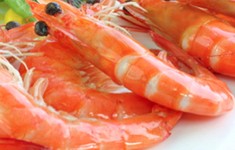 A key Chinese shrimp exporter is blaming competition from Ecuador and Thailand for a woeful 2012 financial performance that will disappoint investors funding capacity expansion in the country’s seafood sector., Zhanjiang Guolian Aquatic Product Co., based in the Guangdong port city of Zhanjiang, in its annual report told investors its net loss of RMB 226 million (USD 36.8 million, EUR 28.3 million), a year-on-year drop of 2,024 percent, was indirectly due to the European debt crisis.
A key Chinese shrimp exporter is blaming competition from Ecuador and Thailand for a woeful 2012 financial performance that will disappoint investors funding capacity expansion in the country’s seafood sector., Zhanjiang Guolian Aquatic Product Co., based in the Guangdong port city of Zhanjiang, in its annual report told investors its net loss of RMB 226 million (USD 36.8 million, EUR 28.3 million), a year-on-year drop of 2,024 percent, was indirectly due to the European debt crisis.“The firm says that prawn exporters in Ecuador and Thailand shifted focus from the EU to the American market, which is Guolian’s main market, creating intense competition,” said Ding Qingyun, an analyst who follows the firm at Li Cai Zhou Bao, a popular financial reporting weekly that prints analysis of China’s listed companies.
Guolian’s plight may dent investor enthusiasm to fund the ambitious capacity expansion ambitions of Chinese seafood producers, which have used listings on the Shanghai and Shenzhen exchanges to massively expand aquaculture and processing facilities. With a market cap of RMB 2.06 billion (USD 335.3 million, EUR 257.8 million), the firm, which had earlier advised investors that it would report a net loss of RMB 219 million (USD 35.6 million, EUR 27.4 million) in 2012, also blamed returns on low international shrimp prices in 2012. While Guolian’s 2012 revenues at RMB 1.45 billion (USD 236 million, EUR 181.4 million) were up 10.4 percent year-on-year, the firm’s average unit share price was down 11.63 percent. The rising cost of raw materials was also cited.
“Guolian missed the right time of purchase in July and August when the price was at the lowest point,” said Ding.
Company General Manager Chen Han told Chinese media recently that Guolian’s profits have been hit by the firm’s misjudgments of the shrimp market in 2012. The company reportedly took orders well before shrimp prices resurged later in the second half of 2012 due to disease and typhoon-related shortages.
A Walmart supplier (it also processes tilapia), Guolian faces the prospect of delisting from the Shenzhen Stock Exchange according to rules that punish a third consecutive year of losses. Chen Han has pledged return to profitability this year, citing the maturity of cultivation and processing projects that the company has invested in. However, investors have been worried that Guolian has spent most of the RMB 1.09 billion (USD 177.4 million, EUR 136.4 million) it raised from an IPO – it had spent RMB 946 million (USD 154 million, EUR 118.4 million) by the end of 2012 with little to show. The firm has yet to finish seven of nine cultivation and processing projects.
“This suggests that it still hasn’t solved its industry value chain,” noted Ding. Interestingly, there was no mention in its annual report of the company’s. investment of RMB 1 billion (USD 162.8 million, EUR 125.1 million) in a 1,000 hectare shrimp farm in Malaysia, part of a joint venture with Ocean Aquatic Marine (M) Sdn Bhd announced late last year.
Guolian’s claims about pressure from Ecuadorian and Thai competition neglects the fact that China is in fact importing shrimp from Ecuador, Southeast Asia and India for processing and re-export. New York-based aquaculture consultant Jayendran Muthushankar points to rising Chinese demand for Indian shrimp being imported via Vietnam. He explained that China’s superior logistics and processing infrastructure,as well as overseas marketing networks, means it will continue to dominate the shrimp-processing scene in major export markets.
China’s shrimp farm-gate purchase prices are increasingly driven by domestic consumption, with key festivals driving seasonal price and consumption increases. Shrimp prices tanked in June 2012 at RMB 12 (USD 1.95, EUR 1.50) for 40-count shrimp, the measurement used by the China Aquatic Channel and the China Aquatic Products Processing and Marketing Alliance. However, prices rose RMB 4 (USD 0.65, EUR 0.50) month on month to RMB 27 (USD 4.39, EUR 3.38) per 40 shrimp in the Pearl River region, which includes Guolian’s home base of Zhanjiang, and RMB 30 (USD 4.88, EUR 3.76) in neighboring Fujian province on the southeast coast. Prices are lower in the less populous production regions of Guangxi (RMB 20 per 40) and Hainan (RMB 20 to21 per 40).





